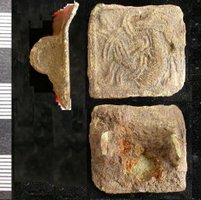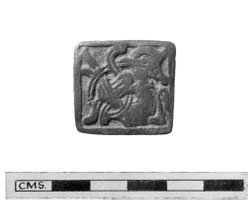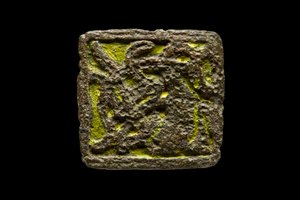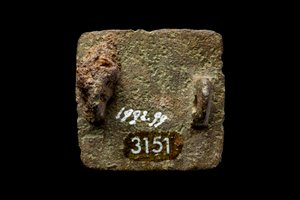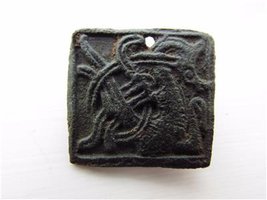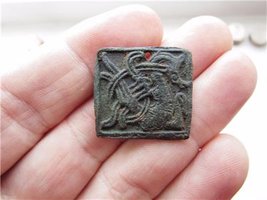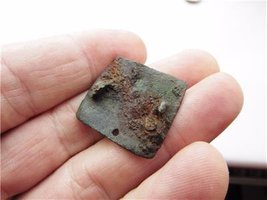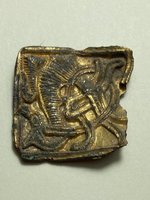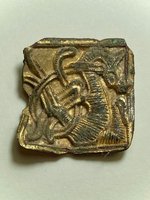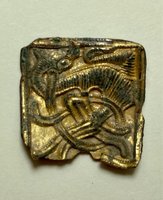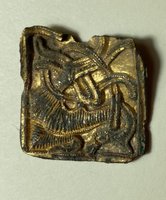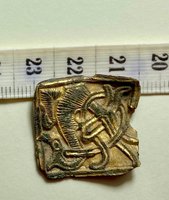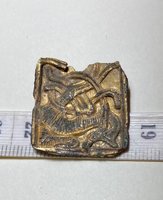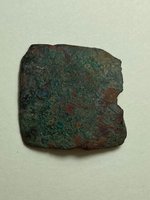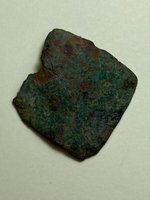Anglo-Scandinavian viking brooch in Mammen style
Copper alloy. Real proportions in picture above.
Found in East-Anglia,
Extremely rare. Just five other examples known to me. ('Mammen style decoration is rare in Britain and this brooch is only one of two rectangular brooches known in England, the other two being from West Stow Heath, Suffolk and Bergh Apton Norfolk').
Addition to Jane Kershaw's reference: the third example - see for reference the link to the PAS reference was found in the region of the East Midlands, County or Unitary in Lincolnshire, district West Lindsey, parish or ward: Linwood.
Executed in the (rarely found in England !) Mammen style, it can be dated to the mid to late 10th century.
Though not find myself and an exact findspot unknown to me, I have recorded it to the Portable Antique Scheme, see:
https://finds.org.uk/database/artefacts/record/id/734951
See for reference:
Viking Identities: Scandinavian Jewellry in England by Jane F. Kershaw, p. 116, 117 and 118 (Mammen-style brooches).
Quote:
'Unique for Scandinavian-style ornamental metalwork in England, the brooches depict a Mammen-style bird.... the bird has an arched neck and forward-bent head with round eye and open jaw, together with a double-contoured head lappet; this arhes downwards into interlace with its body and wings before terminating in an open-ended tendril. The wings, represented by a pair of double tendrils, extend diagonally downwards to the bottom left corner and pass behind a similarly constructed tail, extended diagonally upwards. The bird's raised leg, with bent foot, is also visible. This treatment, particularly the movement and open-ended tendril terminal of the head lappet and the use of the tendril ornament to depict the bird's wings and tail, identify the bird with the Mammen style.
Yet whereas the brooch motif is influenced by Scandinavian art styles, its rectangular shape is not Scandinavian in origin. The brooch shape would instead appear to relate to to rectangular and suare brooches found predominantly in northern Germany and the Netherlands: so-called Rechteckfibeln..Square-headed brooches are dated on the Continent to the 10th century, a date wich accords with the appaerance of the Mammen--style in Scandinavia'
Also see the Viking-Age Scandinavian art styles and their appearance in the British Isles Part 2: Late Viking-Age art styles datasheet from The Finds Research Group:
The Portable Antiques Scheme addresses three other examples of this specific kind of brooch. The first one - wich had been returned to the collector one can see above. Information in detail can be found via this link to the object in the PAS website:
Two other examples of this kind of brooch are in the Ashmolean Museum in Oxford.
AN1909.425 Square headed brooch; animal decoration in relief, bronze and enamel, West Stow Heath, Suffolk, Anglo-Saxon Period (AD 400 - 1066)
© Ashmolean Museum, University of Oxford (black and white image herunder)
The second brooch with inventory nr. AN1992.99 Square brooch with relief design, bronze and enamel, Bergh Apton, Norfolk, 900 – 1025.
© Ashmolean Museum, University of Oxford (images front and back hereunder).
The document beneath is the inventory of the Ashmolean Museum of the two brooches (wich are on display). Remarkably they state that: 'only one AN1909.425 ‘is identified as ‘Jellinge’ style, a rare Anglo-Danish design not commonly found in England’.
As the use of 'Anglo-Danish' may be the case being used in inventory registers in English musea, I prefer the term 'Anglo-Scandinavian, as considering Jane Kershaw's remarks, it is very likely that they were produced within the Danelaw, the area where at least 3 and presumably also my example was being found.
As Jane Kershaw categorize this type of brooch as 'Mammen style' I underscribe that typification (also).
Out of the blue, a fifth (perforated) example popped up on Ebay in January 2015..
The description on Ebay said that it was found in Cambridgeshire.
The buyer made an interesting blog wich can be read here:
http://lifeartearth.blogspot.nl/2016/02/the-viking-mammen-style-on-rare-british.html
October 2020 I got an email that a sixth example was found on a field in Suffolk, England. Full gilded on the front it is a remarkable find, standing on its own compared with the previous known examples. It would be worthwile to examine if these kind of brooches, exclusively as it seems, being found in England, also had been found in other countries/areas. For now it seems they have been produced locally somewhere in England.
Well. I could have been with these stones until after dark, but as my wife wanted to travel on.. well.. I see you again, some day, hogback stones from Gosforth. And if you happen to be there one day, do not forget that monument on the outside...
Further on with the Cumbrian hogbacktour !
In - yes, luckily again in - St. Peter's church in Heysham, there is a truly beautiful hogback stone. The guide told us, it had been studyied by Thor Ewing, a writer, in 2000. in 'Understanding the Heysham hogback' A tenth century sculpted stone monument and its context (link), Thor Ewing tells in detail what he dicovered on the both sides of this hogback stone.
Just being brought in the church as late as the 1970's accompanied with some protest here and there among the church visitors, considered as being a token of old paganism, it had been remarkably nice preserved, and a lot of detail can be seen, still. Truly worthwile a visit.
I had a small debate with the guide in the church if the - zoomorphic, in my opinion - faces on the sides were lions (or hippo's). The guide doubted if the vikings could have known about lions. Well I guess so, concerning the runes on the Ancient Greek lion statue at the Arsenal, Venice. For example. Vikings did travel south..
But when he told me he was doubting the vikings 'discovered' (as the native inhabitants were of course, in the first place) America before Columbus, I decided to rest my case..
One has to know when to start and to end a conversation ..
Just discovered the book in a bookstore written by Geoff Holder - The guide to the mysterious Lake District, I knew there had to be another hogback stone in Lowther, St. Micheal's Church. With a promising image described in the text of 'a naval and a land-based force of shield-bearing vikings above a fish and what might be a coiled sea serpent. On the reverse is a row of female figures with snakes, possibly a representation of the hideous hag Hel'. Wow. If that did not sound as a true pagan promised land ..
Not complaing too much after all we have seen, this visit was the dissapointing one of them all. But if you wife states 'I am happy to have seen them' and I am answering 'Measuring is knowing' and the even more obligate verb 'handling 'if we did not see it at all, we wouldn't have known anything at all of how they were looking' the glass was again half full, at the last day of our journey..
The hogback stone appeared to be just being tolerated within the entrance segment part of the church. As something you never use anymore but you do not throw away - entirely. That sort of feeling emerged when seeing this hogback asylum seekers.. Bed, bath and bread, ás we say in Dutch, but no luxury at all and standing on some outcuts of wood, you would balance the table with at home..
Come on, St. Micheal's Church.. care a bit more of your 'children' !
This hogback stone was moved in the church in 1907. Hogback stones layed partially buried in the churchyard before it was dug up and moved into the church.
The promising depiction of a longship - as certainly can be seen after some studying - see http://vikingminds.co.uk/pages/longship
we have missed !
The stone itself is (157 x 50 x 30 cm) and very worn.
The hogback stones in Cumbria - very diverse in quality, but everyone worth a visit ! Especially on a gloomy day in late October ...
The churches to visit - see photos of resp. St. Andrew's church in Penrith, St. Mary's church in Gosforth, St. Peter's church in Heysham and St. Micheal's church in Lowther.
Did I miss out on another one in Cumbria ? Let me know !
In a next blog I will take you to four - still remaining utterly mysterious- statues 'guarding' the graveyard of St. Andrew's church in Dacre..
For the last blog of October 9th see this link.
References: (as always, links to where the books can be ordered are attached).
Edwards, B.J.N. Vikings in North West England - The artifacts (1998);
Emery, Gordon, CURIOUS CUMBRIA, The Lake District & Beyond: A celebration of Cumbria (2023)
Ewing, T. 'Understanding the Heysham hogback' A tenth century sculpted stone monument and its context ;
Hall, R. Viking Age archaeology in Britain and Ireland (first printed 1990, reprinted with amendments in 1995);
Holder, G. The guide to the mysterious Lake District (2009)
possibly also (as there within the part of Cumbria dealing with Carlisle, the Eden Valley, Barrow-in-Furness, Whitehaven and the west coast is being dealed with)
Holder, G. Paranormal Cumbria (2010)
http://vikingminds.co.uk/pages/longship


